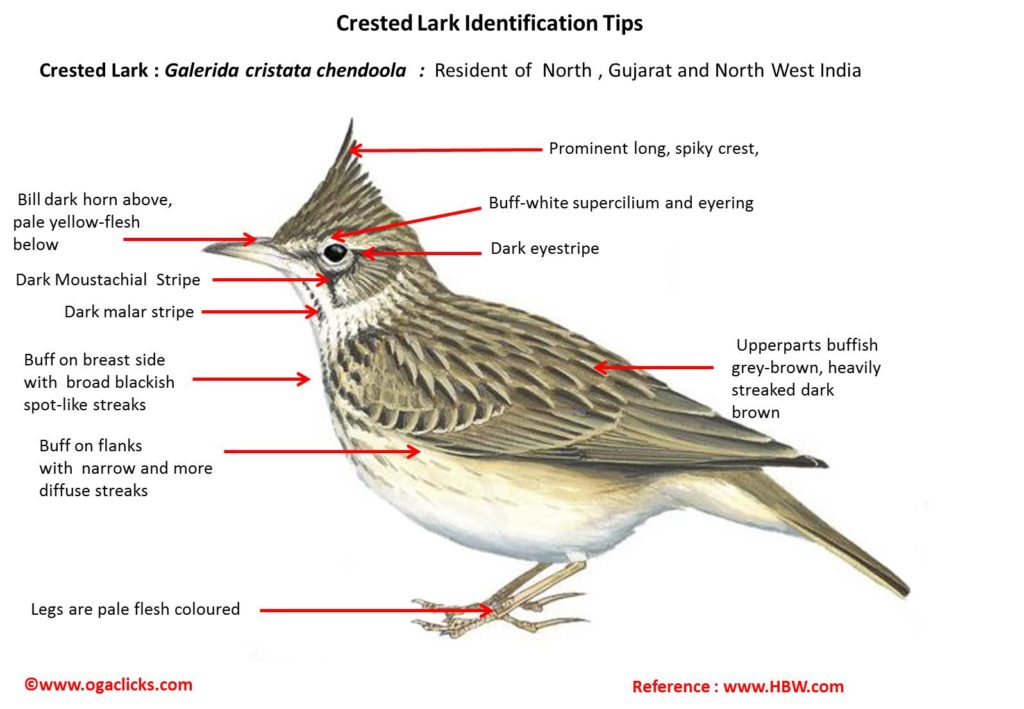
Crested Lark Galerida cristata
Etymology:
- Galerida : latin word for Lark with a crest derived from galea – helmet
- Cristata : Latin for Crested derived from crista – crest,plume
Vernacular Names: Baluchistan: Chagok, Chotab, Chagul, Persian: Kamalak, Hindi: Samanya Chandul, Pun: Bodal chandol, Top chiri, Guj: Ghaghas chandul, Moto chandul, Kan: Turayi bharadwaja, Mar: Turewala Chandol
Distribution in India: Widespread resident in North and North-West India
Description: Size of 15-18 cm. It is a medium-sized, rather bulky lark with prominent long, spiky crest, rather long bill, relatively short and broad wings rounded at tip, very short primary projection, narrow and pointed at tip outer primary reduced, rather short tail, hind claw long and straight. The nominate race has buff-white supercilium and eyering, dark eyestripe and moustachial and malar stripes. The crown and upperparts are buffish grey-brown, heavily streaked dark brown; hindneck and rump are less streaked. The flight-feathers are olive-brown, narrowly edged buffish to light cinnamon; tail has olive-brown central feathers, rest is black, except for distinctive buff-brown outer feathers. It is whitish below, more buff on breast side and flanks, broad blackish spot-like streaks on breast, narrow and more diffuse streaks on flanks. The axillaries and underwing-coverts are rusty. The bill is dark horn above, pale yellow-flesh below; legs pale flesh. Both the sexes are similar.
Habitat:It is found in dry plains with sparse vegetation cover and dry cultivations. Also found in open farm, steppe and deserts, sandy semi-desert land and dry cultivations. Also found in forest clearings and Savanna. Found from low or middle altitudes, usually avoiding mountain areas, up to 2300 m.
Food habits : It eats Invertebrates, seeds and green material; mainly invertebrates in spring-summer and seeds during autumn-winter. It eats a very wide assortment of invertebrates, like beetles, grasshoppers , ants, caterpillars, snails and spiders. The nestlings fed exclusively with invertebrates. It forages on ground, singly or in pairs; It searches the ground for food by digging holes, also digs in horse dung. Breaks open snail shells by smashing them against stone or similar hard object. It regularly needs to drink water.
Breeding habits: They breed in Apr in Spain, Apr–May in Mali, Nov–Mar and May in Nigeria, Dec–Mar in Ethiopia, Apr–May in Somalia, and Mar in E Africa; breeds Mar–Aug in Pakistan and India. They are Monogamous, solitary and territorial. The mating display by male is a song flight .The nest is built by female alone. The nest is an untidy lining of grass or other vegetation placed in depression on ground, openly or beside shrub. They lay a clutch of 3–5 eggs; replacement laid if clutch destroyed or lost. The incubation is done by female alone, beginning with last or penultimate egg, for a period of 11–13 days. The chicks are fed and cared for by both parents. The nestling period is 9–13 days .The young begin first flights at 15–16 days, capable of full flight at 20 days.